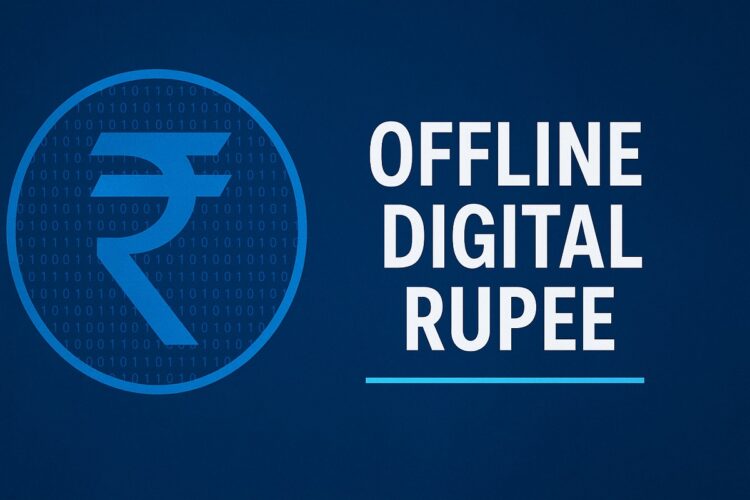In a world increasingly dependent on connectivity, the Reserve Bank of India (RBI) has taken a groundbreaking step to make digital transactions truly universal — by launching the Offline Digital Rupee (e₹). This innovative feature enables payments and money transfers without the need for internet access, making it possible for users in remote, rural, or low-network areas to carry out cashless transactions with ease.
Unveiled during the Global Fintech Fest 2025 in Mumbai, the Offline Digital Rupee marks a crucial advancement in the Central Bank Digital Currency (CBDC) journey. It combines the trust of physical cash with the convenience and security of digital payments, reinforcing India’s leadership in the global digital finance ecosystem.
What Is the Offline Digital Rupee?
The Offline Digital Rupee (e₹) is a form of digital legal tender issued directly by the Reserve Bank of India. It holds the same value, status, and trust as the physical Indian rupee but exists entirely in a digital format. Simply put, it’s “cash in digital form.”
What makes the Offline e₹ unique is its ability to function without an internet connection. Unlike popular payment systems like UPI or mobile banking that depend on network connectivity, the Offline Digital Rupee allows transactions to occur even when there is no mobile data or Wi-Fi.
The RBI describes it as a currency that “works everywhere” — from metropolitan cities to the remotest Himalayan villages. It’s designed to empower those who are currently left out of the digital economy due to poor internet infrastructure.
How Does the Offline Digital Rupee Work?
The working principle of the Offline Digital Rupee revolves around device-to-device communication. It uses advanced technologies like Near Field Communication (NFC) and QR codes to facilitate instant transfers between users, much like exchanging cash by hand.
Here’s a simple step-by-step breakdown of how it works:
- Download the e₹ Wallet App
Users need to download the e₹ wallet offered by their bank (such as SBI, HDFC Bank, ICICI Bank, or others). The app is available for both Android and iOS devices. - Add Money to Your e₹ Wallet
Digital rupees can be added to the wallet by converting funds from a linked bank account. Once added, the amount appears as e₹ tokens — the digital equivalent of physical notes. - Make or Receive Payments Offline
Users can pay by tapping their phone using NFC or scanning a QR code, even without internet access. The transaction gets stored locally on the device until connectivity is restored, ensuring smooth operation in areas with weak signals. - Automatic Syncing
When the device reconnects to the internet, the transaction data automatically syncs with the central ledger maintained by the RBI, updating balances securely.
Through this mechanism, the Offline Digital Rupee mimics cash-like immediacy and privacy, while still being completely traceable and accountable to the RBI.
Features That Set It Apart
The RBI’s Offline Digital Rupee is not just a digital wallet — it’s an entirely new form of sovereign currency. Some of its most defining features include:
- Legal Tender: Backed by the RBI, e₹ is recognized as a valid medium of exchange for all transactions.
- Programmable Money: Funds can be pre-coded for specific uses, such as government subsidies, employee reimbursements, or welfare disbursements.
- No Bank Account Needed: Unlike mobile banking, the e₹ can be used through a wallet without maintaining a bank account.
- Cash-Like Behavior: Transactions settle instantly and can be done directly between two users.
- Offline Functionality: Works in low or no-internet areas — ensuring true accessibility.
These attributes make the e₹ a significant step toward a resilient, inclusive, and future-ready payment system.
Who Can Use the Offline Digital Rupee?
The Offline Digital Rupee has been designed to cater to all sections of society. It is particularly beneficial for:
- Rural populations in regions with limited internet penetration.
- Small businesses and vendors, such as shopkeepers, vegetable sellers, and hawkers.
- Travelers in areas with low connectivity like hills, forests, or remote towns.
- Government and welfare agencies distributing funds directly to beneficiaries.
In short, anyone with a smartphone or digital wallet can use the Offline e₹ — making it India’s most inclusive digital currency initiative yet.
The Banks Powering the e₹ Ecosystem
As part of its phased rollout, the RBI has partnered with 15 major banks to issue and support e₹ wallets. These include:
| Bank | Wallet Name |
|---|---|
| State Bank of India | eRupee by SBI |
| ICICI Bank | Digital Rupee by ICICI |
| HDFC Bank | HDFC Bank Digital Rupee |
| IDFC First Bank | IDFC First Digital Rupee |
| Punjab National Bank | PNB Digital Rupee |
| Union Bank of India | UBI Digital Rupee |
| Bank of Baroda | BoB Digital Rupee |
| Axis Bank | Axis Digital Rupee |
| Kotak Mahindra Bank | Kotak Digital Rupee |
| Yes Bank | Yes Bank Digital Rupee |
| IndusInd Bank | IndusInd Digital Rupee |
| Canara Bank | Canara Digital Rupee |
| Indian Bank | Indian Bank Digital Rupee |
| Federal Bank | Federal Digital Rupee |
| Karnataka Bank | Karnataka Digital Rupee |
This wide participation ensures that the Offline e₹ ecosystem has a robust banking backbone from the start.
Advantages of Using the Offline Digital Rupee
The Offline e₹ offers multiple advantages for users, merchants, and the broader economy:
1. Inclusive Access
It brings digital payments to the unconnected, allowing people in villages and border regions to participate in India’s growing digital economy.
2. Instant and Secure
Transactions are immediate and RBI-guaranteed, ensuring finality of payment without the risks of cash handling.
3. Cost-Effective
With no intermediaries or network charges, it reduces transaction costs — ideal for micro and small businesses.
4. Government Efficiency
The programmability of e₹ ensures direct and targeted transfers, minimizing leakage in subsidy schemes.
5. Interoperability with UPI
The e₹ can seamlessly integrate with the Unified Payments Interface (UPI) ecosystem, allowing interoperability across payment platforms.
The Global Significance of India’s Offline e₹
India’s Offline Digital Rupee has drawn global attention as one of the first operational offline CBDCs in the world. While many countries are still experimenting with pilot projects, India’s large-scale rollout has positioned it as a fintech pioneer.
Central banks from Africa, Southeast Asia, and Europe are studying India’s model for potential adaptation in their economies. The initiative also aligns with India’s Digital Public Infrastructure (DPI) vision — demonstrating how technology can drive equitable access to financial services.
Challenges Ahead
Despite its promise, the Offline e₹ will need to overcome challenges such as:
- Consumer awareness: Rural users must be educated on safe usage.
- Device compatibility: Not all phones support NFC-based payments.
- Cybersecurity: Strong safeguards are essential to prevent fraud and duplication.
The RBI has already begun pilot programs and awareness campaigns in collaboration with banks and fintech companies to address these issues before full-scale implementation.
You Learn
The Offline Digital Rupee represents more than a financial innovation — it is a social equalizer. By bridging the gap between connected cities and offline regions, the RBI has created a digital payment solution that truly embodies inclusivity.
With its offline functionality, cash-like simplicity, and robust security, the e₹ could redefine how India transacts — and how the world perceives digital currency. As the system matures, it will likely become an integral part of India’s everyday economy, ensuring that no one is left out of the digital revolution, even when the internet isn’t available.
(India CSR)





